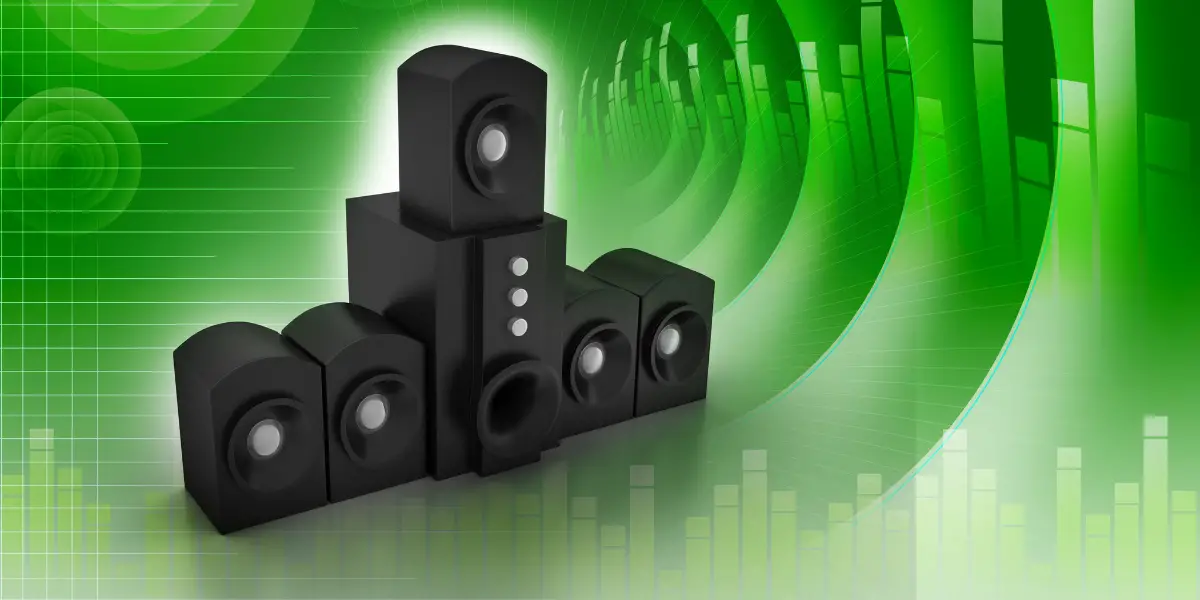Picture this: you’ve finally invested in that high-quality audio system you’ve been dreaming about, and you’re ready to put it to the test. You’ve spent hours curating the perfect playlist, filled with your favorite tunes, ready to be enveloped in the immersive, crystal-clear sound.
But even with top-notch gear and an impressive setup, something feels… off. The audio experience just isn’t what you expected it to be. It’s time to face the music and admit that the key to truly exceptional audio lies in strategically placing your speakers within your listening space.
When placing speakers in a room, it is important to consider the size and shape of the room, the acoustics, and the listening position. Ideally, the speakers should be positioned at ear level, slightly angled towards the listening area, and at a distance from the wall. It is also recommended to experiment with different placements and listen for the best sound quality.
In this blog post, we are going to share with you the secrets of perfect speaker placement, taking the guesswork out of the process and guiding you on your journey to audio nirvana.
With our expert tips and tricks, you’ll be able to transform your listening room into a space that caters to high-quality sound, fully maximizing your audio system’s potential. Say goodbye to average sound, and get ready to discover the true art of speaker placement.
The importance of speaker positioning for optimal audio experience
Achieving the best possible audio experience in a listening environment depends greatly on the speaker positioning within the room.
Properly placing speakers can significantly enhance the performance of even the most affordable audio equipment, allowing listeners to fully appreciate the sound quality without making costly upgrades to their existing setup.
Implementing best-practice guidelines for speaker placement is crucial for audiophiles looking to create an immersive and well-balanced listening experience, regardless of their budget.
Speaker positioning plays a key role in reducing the potential negative impacts of room acoustics and optimizing the delivery of sound to the listener’s ears.
By following essential principles such as setting up an equilateral triangle between the listener and the speakers, maintaining safe distances from walls and corners, and ensuring a clean line of sight for the audio waves to travel, one can significantly enhance the sound clarity, balance, and overall listening experience.

Additionally, paying attention to the unique characteristics of the room, such as floor surfaces, furniture arrangement, and time of day for audio usage, can also contribute to creating the optimal audio environment. Incorporating acoustic treatments like isolation pads or curtains can further minimize sound reflections and resonance, leading to a more satisfying audio experience.
In conclusion, investing time and effort into proper speaker positioning can greatly impact the enjoyment of audio in any space. By following the best-practice guidelines and considering individual listening preferences, listeners can create an optimal audio environment that delivers the full potential of their audio equipment.
Choosing the right amplifier and source for your hi-fi system
Setting up an impeccable hi-fi system requires a combination of good source components, the right amplifier, and matching speakers. The key to attaining an enjoyable listening experience lies in selecting amplifiers and sources that complement each other to create a harmonious sound.
One effective approach in selecting an amplifier and source is to stick within a single brand’s range, as they are likely engineered to work well together. However, if you wish to mix-and-match components from different brands, always be diligent in testing various combinations to see which pairing works best.
When choosing an amplifier, it is important to consider its power output (measured in watts), impedance (measured in ohms), and speaker sensitivity (dB).
These specifications determine how efficiently your amplifier drives your speakers. Comparing the power output into 8 ohms and 4 ohms helps gauge an amplifier’s muscularity.
Ideally, an amplifier should double its output as impedance halves; the closer it gets, the better. It is also important not to pair a bright-sounding source, e.g., a CD player, with an amplifier of the same character.
Ultimately, the best test for a successful hi-fi system is your ears. Trust your instincts when listening to various combinations and configurations, as they’ll guide you to the most satisfying outcome.
Investing time in choosing the right amplifier and source can make a world of difference in your hi-fi system’s performance, ensuring an enjoyable and immersive sound experience.
Maximizing sound quality with a digital to analogue converter
Achieving optimal sound quality in your listening space can be greatly enhanced by incorporating a digital to analogue converter (DAC) into your audio setup.
A DAC is an essential component that helps to convert digital audio signals from your computer, mobile device, or streaming service into high-quality analogue signals, elevating the listening experience.
One of the crucial factors to consider when choosing a DAC is its compatibility with your digital sources. Ensure that the DAC supports the required digital inputs and outputs, such as USB, coaxial, or optical connections.
Another factor is the resolution of the DAC, which refers to the accuracy and precision of the digital-to-analog conversion process. A higher resolution DAC will deliver more detailed and accurate sound reproduction.
Placement of the DAC in your room is also essential for achieving the best sound quality. It should be placed away from other electronic devices to minimize interference and noise. If possible, it should be placed near your audio source and amplifier to minimize the length of the cables connecting them.
In addition to the proper placement of speakers and DAC, the quality of cables used to connect your components also plays a significant role in ensuring optimal sound quality. High-quality cables minimize signal loss and interference, ensuring that the audio signal remains clean and clear throughout the entire signal chain.
In conclusion, incorporating a DAC into your audio setup, along with ideal speaker placement and high-quality cabling, can greatly enhance the sound quality in your room. Experimenting with different placements and setups will help you achieve the perfect balance for an immersive and enjoyable listening experience.
Enhancing vinyl recordings with a good phono-preamplifier
To truly appreciate the rich and dynamic sound of vinyl records, investing in a good phono-preamplifier is essential.
A phono-preamplifier, also known as a phono stage, serves two primary functions: it amplifies the delicate signal from the turntable’s cartridge and applies equalization to correct for the inherent imbalances of the vinyl format.
By selecting a high-quality phono-preamplifier, listeners can achieve a significant improvement in the overall sound quality and enjoyment of their vinyl recordings.
First and foremost, a good phono-preamplifier provides the necessary amplification for the cartridge’s low output signal.
This is crucial because the signal undergoes multiple stages of amplification in the audio chain, and any noise or distortion introduced at this early stage will be amplified as well. A high-quality phono stage ensures an accurate and noise-free signal, allowing the listener to truly appreciate the nuances of their favorite vinyl records.
Additionally, a good phono-preamplifier applies equalization to correct for the vinyl format’s limitation.
The RIAA (Recording Industry Association of America) equalization curve was established to minimize vinyl’s inherent noise and maximize playback fidelity.
A quality phono-preamplifier will accurately apply this equalization, resulting in the correct reproduction of the music’s original frequency balance, as intended by the artists and producers.
In conclusion, investing in a good phono-preamplifier is an essential step for any vinyl enthusiast seeking to enhance their listening experience. By amplifying the cartridge’s signal without introducing noise or distortion, and by accurately applying the RIAA equalization curve, a high-quality phono stage can elevate the rich and vibrant sound of vinyl records to new heights.
Considerations when using a stereo receiver with built-in radio capabilities
When using a stereo receiver with built-in radio capabilities, there are several factors to consider to ensure optimal performance and enjoyment. In this article, we will discuss five essential considerations to keep in mind when setting up your home audio system.
- Location: Choosing the right location for your stereo receiver is crucial, as it houses the radio tuner and other essential components. Ensure that the receiver is placed in a well-ventilated area and positioned away from other electronic devices that may cause interference.
- Antenna: A strong and clear radio signal is essential for achieving the best audio quality. Most receivers come with an FM antenna, but it is worthwhile to invest in a quality indoor or outdoor antenna if you live in an area with poor reception. Properly positioning and grounding the antenna will also improve the signal.
- Speakers: Just as important as the receiver, quality speakers are an essential component to achieve optimal audio quality. Choose speakers that suit your listening preferences as well as the size and layout of your room. Speaker placement also plays a significant role in enhancing the listening experience, with the ideal arrangement typically being a stereo pair spaced evenly at ear level.
- Compatibility: Ensure that all the components of your audio system, such as CD players or turntables, are compatible with your stereo receiver’s connectivity options. This will allow for seamless integration and optimal performance.
- Presets and Tuning: Most modern receivers with built-in radio capabilities allow users to save their favorite stations as presets. Taking the time to program these presets will significantly enhance your listening experience and make it more convenient to switch between your favorite stations. Furthermore, it is essential to fine-tune the radio settings to get the best possible reception, including adjusting the radio sensitivity and other available settings.
In conclusion, when using a stereo receiver with built-in radio capabilities, it is essential to give proper attention to factors such as location, antenna, speakers, compatibility, and tuning to ensure a high-quality audio experience. By taking these considerations into account, you can enjoy your favourite radio stations with optimal sound quality and performance.
The convenience of network players for streamed music
In today’s digital age, network players and smart speakers have become increasingly popular due to their ability to offer the convenience of streaming music across various platforms. These devices bring a plethora of benefits to music enthusiasts, catering to the needs of audiophiles as well as casual listeners who prioritize convenience and ease of use.
One of the primary advantages of network players is their versatility in supporting multiple streaming services and audio formats. They are compatible with popular platforms such as Spotify, Tidal, and Deezer, as well as high-resolution audio formats like FLAC and DSD. This allows users to access a vast library of music at their fingertips, eliminating the need for physical media such as CDs and vinyl records.
Additionally, network players can seamlessly integrate with existing home audio systems, allowing users to enjoy high-quality streaming music without the need to replace their entire setup.
These devices can connect via Wi-Fi or Ethernet, ensuring a stable connection for uninterrupted audio streaming. With the integration of smart home technology, network players can also be controlled using voice commands or mobile applications for further convenience.
Furthermore, multi-room audio capability is another key feature of network players, enabling users to stream music to different zones in their home simultaneously. This means that multiple users can enjoy their preferred music selections in different rooms with individual volume controls, creating a personalized audio experience.
In conclusion, the convenience of network players for streamed music has transformed the way people listen to and enjoy their favourite tunes.
With their compatibility with various streaming platforms, seamless integration with existing audio systems, and multi-room audio capabilities, these devices have become an integral part of modern-day home entertainment systems.
How to arrange furniture and speakers for best performance in multi-use rooms
Creating the perfect audio experience in a multi-purpose room can be quite a challenge. Fortunately, with careful planning and consideration, you can optimize your room for both everyday activities and movie nights or music sessions. Here are some tips on how to arrange furniture and speakers for the best performance in multi-use rooms:
- Prioritize the main purpose of the room: Determine whether the room is mainly a living space, home theater, or music room, and arrange your furniture accordingly. This will guide you on where to place your speakers for an optimal listening experience.
- Proper speaker placement: Ensure your speakers are placed at an appropriate distance and angle from your primary seating area. Typically, front speakers should be 2-3 feet away from walls and angled towards the listener, while rear surround speakers should be directly to the side or slightly behind the listener.
- Flexible seating options: Choose seating that can be easily moved and rearranged. This allows you to adjust your room layout based on the activity.
- Use speaker stands and mounts: Station smaller speakers on stands or shelves at approximately ear height when seated to improve sound quality. Use mounting brackets for rear surround speakers to keep them at an optimal height without taking up floor space.
- Minimize sound reflection: Avoid placing furniture or objects directly in front of speakers, as they can distort or blur the sound.
- Consider acoustic treatments: Adding carpets, curtains, and other soft furnishings can help absorb excess sound and prevent unwanted echoes.
- Be prepared to experiment: Every room is unique, so don’t be afraid to try different furniture and speaker arrangements to find the perfect balance between functionality and sound quality. The key is to strike a balance that allows you to enjoy excellent audio performance while maintaining the room’s versatility for various activities.
The impact of reflective surfaces on sound quality and how to mitigate it
When it comes to achieving optimal sound quality in a listening space, reflective surfaces can have a significant impact on the overall listening experience. These surfaces can cause sound waves to bounce and reflect in various directions, leading to distortions and a less focused stereo image.
In order to minimize these negative effects, it is crucial to consider the role of reflective surfaces in the room and take steps to mitigate their impact.
Firstly, speakers should be positioned at least 2-3 feet away from nearby walls, and especially from corners, as these can cause sound waves to reflect and create muddy and unclear audio. Rear bass ports should also be kept at an appropriate distance from walls, in order to minimize reflections and potential distortion.
In addition to adjusting speaker placement, it is also essential to examine the room’s furniture and layout. Strive for symmetry in the arrangement of furniture and ensure there are no objects obstructing the direct path between the speakers and the listener’s ears. This will help to minimize sound reflections caused by various surfaces and optimize overall audio clarity.
Finally, consider using acoustic treatments, such as foam panels and bass traps, to absorb and control sound reflections. These can be strategically placed on walls, ceilings, and corners to ensure a more balanced and precise listening experience.
By properly addressing the impact of reflective surfaces on sound quality, listeners can enjoy a more immersive and engaging audio experience in their rooms.
Properly running in speakers before judging their performance
When it comes to achieving the best possible sound from your speakers, it’s crucial to understand the significance of properly running them in before you start judging their performance. This process, often referred to as the ‘break-in period,’ is essential because it allows the components within the speakers to warm up, stretch out, and settle into their optimal working condition. Failing to run in your speakers can lead to distorted sound and a poor listening experience.
Typically, most speakers require around 24 hours of continuous usage to be fully broken in. However, some may even take almost 100 hours before reaching their peak performance.
It is essential to note that you should avoid subjecting your speakers to very high volumes during this period, as it might cause unnecessary strain on the components. Instead, gradually increase the volume levels, allowing your speakers to ease into their optimal performance.
Consulting the manufacturer’s manual for specific run-in recommendations for your speakers is always a smart move. However, ultimately, it’s up to you to be patient and afford your speakers the time they need to reach their full potential.
Remember, a well-executed break-in period can lead to significant improvements in sound quality, enabling you to fully appreciate the true capabilities of your audio system.
So, ensure you invest the time and effort required for properly running in your speakers before passing any judgments on their performance.
How Does the Placement of Speakers in a Room Impact the Sound Quality Compared to Open or Closed Headphones?
The placement of speakers in a room can greatly impact the sound quality compared to open or closed headphones. The positioning of speakers can affect how sound waves travel and interact with the room, leading to differences in sound dispersion, frequency response, and overall listening experience compared to using headphones.
What is the best placement for a mini Bluetooth speaker in a room?
When deciding on the best placement for a mini Bluetooth speaker, consider a spot near ear level and away from walls to avoid distortion. Experiment with different locations to find the perfect balance between sound quality and convenience. For more tips, check out a comprehensive mini Bluetooth speaker review.
The importance of investing in quality stands, spikes, and speaker cable for optimal support and performance.
The importance of investing in quality stands, spikes, and speaker cable for optimal support and performance
In order to achieve the best possible sound quality from your audio system, it is crucial to invest in high-quality accessories such as speaker stands, spikes, and cables. These components can significantly improve the overall performance and aesthetic appeal of your setup.
Speaker stands are essential for providing stable, vibration-free support to your standmount speakers, which can greatly impact the sound quality.
A sturdy stand ensures that your speakers are positioned at the optimal height and angle, improving stereo imaging and reducing unwanted reflections off surfaces. Moreover, specialized speaker stands are designed to minimize resonance and vibrations, ensuring that the audio being delivered is clear and accurate.
Spikes, on the other hand, are attached to the base of your speaker stands or floor-standing speakers. These spikes serve as isolators that prevent vibrations from the speaker from reaching the floor, resulting in a tighter and more focused bass response. This isolation is particularly important if you have wooden floors, as it prevents the sound from being muddied by floor vibrations.
In addition to speaker stands and spikes, it is important to invest in high-quality speaker cables. Good cables ensure that the signal being transmitted from your amplifier to your speakers is clean, without any interference or signal loss. This helps maintain the integrity of the audio signal and delivers a more detailed and comprehensive listening experience.
In conclusion, spending a little extra on quality stands, spikes, and speaker cables will greatly enhance your audio setup’s performance and longevity. By investing in these components, you can ensure that your speakers are optimally supported, allowing them to deliver the best possible sound quality for an immersive and enjoyable listening experience.





